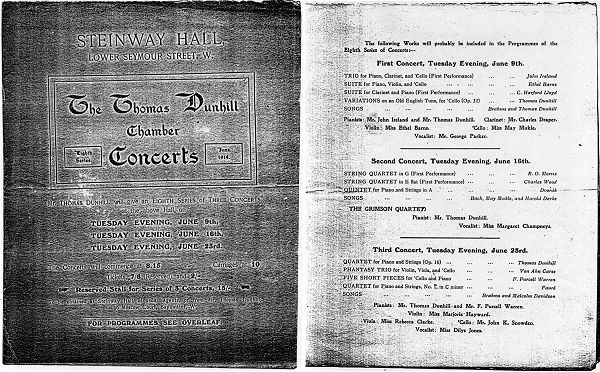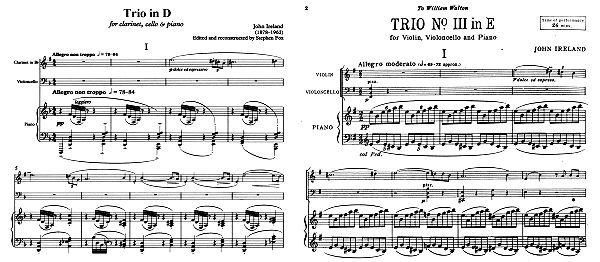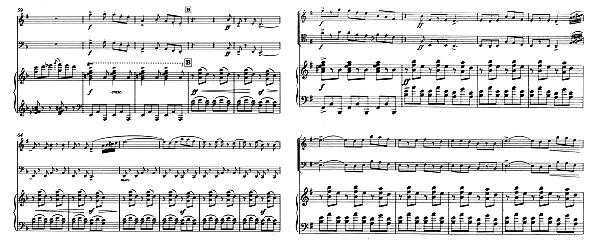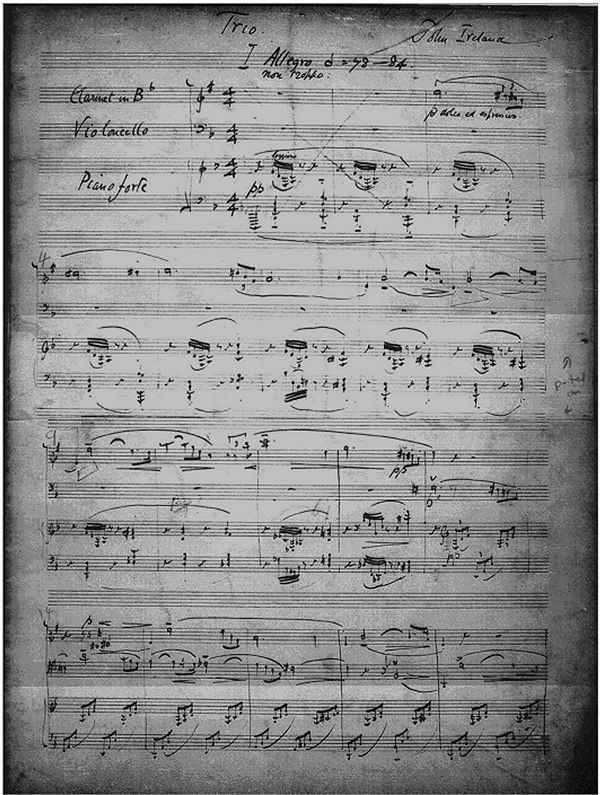The
Clarinet Trio of John Ireland
by
Stephen Fox
Although
it is not difficult to find underappreciated
or forgotten chamber music involving
the clarinet, it is a rare privilege
to resurrect a major work from the dusty
archives where it has lain neglected
for nearly a century. Such is the case
with the Trio in D for clarinet, cello
and piano by John Ireland.
John
Nicholson Ireland (1879-1962) is recognised
now as one of the towering figures in
British music in the first half of the
20th century. Ireland’s distinctive
and highly varied musical style, which
was intensely personal and imbued with
the spirit of Romanticism, grew out
of a rigorous grounding as a pupil of
C. V. Stanford at the Royal College
of Music, blended with the influence
of various contemporary European composers.
He drew inspiration from literary sources
(the fantasies of Arthur Machen and
the Satyricon of Petronius, for
example) and from his love of the English
countryside, although unlike some of
his contemporaries, he did not delve
extensively into folksong for musical
material. He is perhaps best known for
his piano music and songs; and while
he wrote a number of pieces for orchestra,
he never attempted symphonies or operas.
Ireland’s
words "The clarinet is by far
the finest wood instrument…"
testify as to the regard in which he
held the clarinet, an admiration which
stemmed in part from hearing as a teenager
a performance by Richard Mühlfeld
of the Brahms Clarinet Quintet. His
limited body of chamber music is mostly
for strings and piano, and includes
only three works which involve winds,
but all feature the clarinet: the well
known Fantasy-Sonata from the
end of his career (1943); the youthful,
Brahms/Dvořák-inspired
Sextet for clarinet, horn and strings
(1898; a wonderful work which very much
deserves to be better known); and the
Trio in D (1912-14).
History
and source material
The
exact impetus for the composition of
the Trio - for example, whether it was
written for a specific clarinettist
- is not recorded. The manuscript states
that it was begun in April 1912 and
finished in October 1913, and revised
between then and February 1914.
The
Trio received at most two public performances
during Ireland’s lifetime. It is listed
among works which "will probably
be included" in one of the Thomas
Dunhill Chamber Concerts at Steinway
Hall in London, on 9th June,
1914, with Charles Draper (clarinet),
May Mukle (cello) and the composer as
the performers; the listing states that
this would be the "first performance"
of the piece. It also seems to have
appeared on the programme of one of
Isidore de Lara’s War Emergency Concerts,
also at Steinway Hall, on 25th
March, 1915.
Ireland
began shortly afterwards to rework the
piece as a conventional piano trio,
with violin instead of clarinet, transposing
it from D into E; in this form it was
shelved again. Finally, more than two
decades later, material from the work
- radically altered, and with an entirely
new slow movement - was used as a basis
for Ireland’s Trio No. 3 in E for violin,
cello and piano, which was completed
in 1938.
As with
the Sextet, Ireland kept the original
Trio, or at least those parts which
he chose to preserve, stored away but
unpublished for most of his life.
Though he was finally persuaded to release
the Sextet to the public in 1960, the
Trio remained hidden.
On Ireland’s
death his manuscripts were willed to
Norah Kirby, his secretary and housekeeper,
who in turn donated them to the British
Library in London. They were sorted
and arranged by the musicologist Ernest
Chapman, and the volume containing the
surviving parts of the Clarinet Trio
(British Library catalogue number MS
52887) was bound in 1985.
Regrettably,
the manuscript is incomplete; whether
this is due to accidental loss, or to
Ireland’s deliberate destruction of
parts he deemed unworkable, is not known.
The volume - containing the piano score
only; the original clarinet and cello
parts have disappeared - consists of
the following parts of the original
Trio-
- the complete first
movement except for the last few bars
- two pages from one
of the two middle movements
- the complete final
movement
plus
- part of the final
movement of the interim violin version,
with a new introductory section
- an incomplete draft
of an alternative (earlier?) version
of the final movement (for clarinet)
- a couple of short
sketches.
The
Trio is discussed at some length in
Fiona Richards' The Music of John
Ireland, and it is also listed in
Stewart Craggs' John Ireland: a Catalogue,
Discography and Bibliography, both
excellent references. The authors disagree
on the date and venue of the first performance,
however, and Craggs also seems not to
have noticed that the manuscript includes
some material from the interim violin
version.
During
2002-03, with the approval of the John
Ireland Trust, the present writer assembled
the surviving source material and produced
a reconstruction which as far as possible
approximates Ireland’s original version
of the work, given the information now
available. The revived Trio was
given its first performance by the Riverdale
Ensemble in Toronto in June 2003.
The same group was invited to present
it at the ICA ClarinetFest in College
Park, MD, in July 2004. Subsequent
performances have allowed gradual polishing
of the reconstruction and editing. The
first U.K. performance has been given
by Alex South at Glasgow University
in November 2007.
The
world premiere recording has been released
by the Riverdale Ensemble.
Publication
of the Trio has been undertaken by June
Emerson Wind Music in the U.K., from
whom the printed music is now available.

Programme
for (planned) first performance of Clarinet
Trio [enlarged
version]
Analysis
Following
is a discussion of each movement and
an outline of the reconstruction, where
necessary, and editing of the Trio (more
details and a list of specific editorial
points can be found on the internet
at the address listed below).
First
movement:
The
manuscript preserves the first movement
intact (MS pp. 1-16) except for a few
bars on a now-missing last page. Otherwise
the score is largely unambiguous, requiring
merely the deciphering of questionable
notes (resulting from sloppy writing
and ink blots) and numerous editorial
instructions of varying legibility.
The
missing part at the end of the movement,
deduced to be five bars long, has been
restored by close analogy with corresponding
material in the 1938 Trio No. 3: the
last four bars were transferred verbatim
(except for transposition), leaving
only one transitional bar (263) to be
reconstructed. Rebuilding this bar convincingly
was not difficult, given the necessity
to preserve the melody line, the harmonic
progression and the rhythmic pattern
established in the previous bar.
The
evolution of the original Trio into
the 1938 Trio can be illustrated by
comparing the opening material from
each:

Comparison
of opening of first movement of Trio
in D (left) and Trio No. 3 in E (right)
[enlarged
version]
Two
general alterations are apparent. The
original piano accompaniment, which
has a halting feel and a rather sparse
texture, was replaced by a continuously
undulating movement (which is very typical
of Ireland's piano writing). The triplet
figure in the melody line was also expanded
from eighth notes to quarter notes,
which alters the character of the tune
fundamentally, replacing a slightly
martial feel with more expansive lyricism.
The
secondary thematic and development material
in this movement was replaced completely
during the transformation to the 1938
Trio.
This
movement is written for clarinet in
B flat. However, one passage contains
a bottom E flat, unplayable on a standard
clarinet. In the grand scheme this is
not particularly significant - another
harmonically consistent note can be
substituted - but for those who wish
to be completely accurate, an ossia
section has been included in the newly
published edition to facilitate playing
this passage on clarinet in A.
Scherzo:
This
movement is represented by only two
surviving manuscript pages (MS pp. 29-30).
Comparison of these pages with the Scherzo
from the 1938 Trio No. 3, however, reveals
that the material is so similar that
reconstructing at least a reasonable
facsimile of the original movement should
be possible, and this in fact proved
fairly straightforward.
Inspection
displays two general changes from the
earlier to the later Trio: transposition
from D minor to E minor; and transformation
of the original constant 6/8 metre to
irregularly alternating 6/8 and 9/8,
which has been carried out by condensing
the rhythm and dropping beats. Restoration
of the original version thus requires
reversal of this:

Comparison
of excerpt from the Scherzo from Trio
in D (left) and Trio No. 3 in E (right)
[enlarged
version]
When
this is done throughout, the two surviving
pages slot neatly into place - bars
53-109 in the new edition and again,
in part, in bars 187-221 - giving us
confidence that the reconstruction is
a fair rendition of the original. Certainly,
some details could be handled in alternate
ways - the choice of which clarinet
note to extract from violin multiple
stops, amendment of multiple stops for
the cello which are playable in E minor
but not in D minor, whether to transpose
a very high melody line in the violin
down to a more appropriate range for
the clarinet, etc. - but these are minor
matters which do not affect the architecture
or the overall effect of the movement.
The
missing (slow?) movement:
After
completion of the first movement and
reconstruction of the Scherzo, there
is clearly a large gap in the page number
sequence in the manuscript (MS pp. 18-26,
plus or minus a page or two), demonstrating
the existence of a second movement which
is now entirely missing. It is
reasonable to surmise that this was
a slow movement, but other than that
we can say nothing about it.
Lento:
The
manuscript contains one section from
the interim violin version: an introduction,
marked Lento, to the last movement.
The clarinet version did not contain
such an introduction (the last movement
starts at the principal tempo, Con
moto, immediately after the movement
heading "IV"). It is possible that the
musical material in the Lento was similar
to that in the missing second movement,
but that cannot be assumed.
In the
absence of any other slow movement,
the decision has been taken to incorporate
the Lento into the revived Trio. Performers
are invited to make their own judgements
about whether to include it, however.
If nothing else, its inclusion preserves
an interesting and distinctive piece
of Ireland's writing which would otherwise
be lost.
Adaptation
of the Lento requires it to be transposed
down a whole tone - to preserve the
attacca into the finale - and
modification for the clarinet of violin-specific
writing, such as tremolos and one passage
with an extremely high tessitura.
The transposition also makes it necessary
to move the opening and closing cello
melody an octave higher than originally
written.
Final movement:
This
movement is complete in the manuscript
(MS pp. 38-50), so editing for performance
required only interpreting one somewhat
ambiguous cut, deciding how to handle
a pencilled-in instruction to transpose
one section, and some individual note
concerns.
While
extensive structural and detail changes
took place between the Trio in D and
the 1938 Trio, the first and second
themes were preserved intact, though
a third theme in the original was later
dropped.
This
movement is the only one in which clarinet
in A is specified.
Summation
By 1912
Ireland had found his voice as a composer,
so those hearing the Trio for the first
time would likely not be surprised to
learn the identity of its creator. In
its musical language it is worlds away
from, say, the Sextet of only 14 years
earlier. Where Continental musical influences
are still apparent, it is now most often
Debussy, rather than Brahms or Dvořák,
whose shadow is cast over the Trio.
Some parts - the Scherzo and the second
theme in the first movement, for instance
- could not possibly be any nationality
other than British. At times Ireland's
experimentation with compositional technique
is apparent; the Lento, with its ambiguous
piano harmonies over a cello ostinato,
would not be out of place in the work
of a composer of several decades later.
Resurrecting
a piece of music in this way raises
the question of the morality of bringing
to light a work previously suppressed
as unworthy or unfinished by its composer.
Being riven with self-doubt, Ireland
was ruthlessly critical of his own work,
and it was not unusual for him to revise
extensively even compositions which
had already been published; works he
considered irretrievably bad were simply
destroyed. His judgement of the Trio
in D, written in 1943, was that "…The
musical material & the emotional
content were all present in the original
version, but badly expressed & clumsily
managed". Seen in a later light,
however, this condemnation now seems
excessively harsh. The 1938 Trio in
E admittedly shows more polish and the
benefit of 25 years of composing experience;
for example, the opening of the first
movement feels more comfortable with
the later piano accompaniment than with
the pattern first used, and the development
section of the original first movement
unquestionably contains some weak spots.
Overall, though, the original Trio has
sufficient merit that it deserves better
than to be buried forever.
As a
precedent, there is one other example
of a work of Ireland’s - the piano solo
Ballade of London Nights - which
he never finished, and which was completed
and published after Ireland's death.
Ultimately, the John Ireland Trust is
the guardian of the best interests of
Ireland and his memory, and their judgement
as to the suitability of releasing the
Trio is to be respected.
The
Trio in D is a major work with considerable
musical interest and appeal for performer
and listener. As the only piece for
this standard instrumental combination
to be found in the rich and distinctive
genre of British late Romantic music,
it should become a significant addition
to the repertoire.
Acknowledgements
Thanks
are due to all those who have assisted
in this project: Dr. Richard Faria of
Ithaca College for the initial impetus;
the Trustees of the John Ireland Trust,
notably Bruce Phillips and the late
Peter Taylor, for giving their approval
for publication and providing valuable
background information; Alan Rowlands
for his thoughtful suggestions about
the reconstruction; June Emerson for
agreeing to publish the Trio and Rachel
Emerson for overseeing the publication;
Jeanne Roberts for typesetting the music
though many rounds of editing; Russell
Denwood for editorial assistance; Pamela
Weston for her encouragement and for
facilitating contact with the publisher;
Marguerite Baker for including a performance
on the schedule for ClarinetFest 2004;
cellists Laura Jones and Helena Likwornik;
pianist Ellen Meyer for countless hours
spent deciphering and interpreting the
barely-legible manuscript score and
collaboration throughout the process;
and many others who have offered enthusiastic
moral support.
References
Fiona
Richards: The Music of John Ireland
(Ashgate, 2000)
Stewart
Craggs: John Ireland: a Catalogue,
Discography and Bibliography (Oxford,
1993)
John
Ireland: Trio No. 3 in E (Boosey
& Hawkes, 1938)
Further
information
Manuscript:
The British Library, www.bl.uk
Publisher:
June Emerson Wind Music, www.bl.uk
Reconstruction/editing
details: www.riverdaleensemble.com/Ireland_Trio.html
Premiere
recording: www.riverdaleensemble.com/Recordings.html

First
page of manuscript of Clarinet Trio
[enlarged
version]
About
the Writer…
Born
in England and raised in western Canada,
Stephen Fox began his university studies
in physics, achieving a Masters degree,
before deciding to make his career in
music. As an instrument maker (www.sfoxclarinets.com),
he is known worldwide for his custom
artist clarinets and reproduction historical
woodwinds. His lectures and demonstrations
on clarinet acoustics, design and history
have been heard at universities in North
America, Europe and Australia and at
ICA ClarinetFests, and from 1994 to
2004 he taught annually at Musikk Instrument
Akademiet in Norway. An active professional
performer, he plays clarinet, historical
clarinet and saxophone in orchestras
and chamber ensembles, has recorded
three chamber music CDs, has presented
recitals and chamber concerts in several
European countries, in Australia and
across Canada, and has been heard on
air through the Canadian Broadcasting
Corporation, Czech Radio and the Australian
Broadcasting Corporation.
'This article was published
in the December 2007 edition of Clarinet
&
Saxophone magazine (the official journal
of the Clarinet & Saxophone Society
of Great Britain)'.
|

